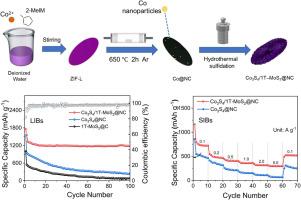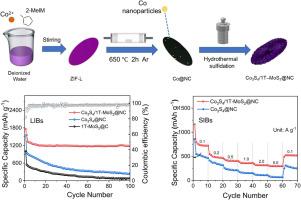Enhancing stable and rapid Li+/Na+ storage performance via interface engineering of confining Co3S₄/1T-MoS₂ heterostructure on nitrogen-doped carbon
IF 5.6
3区 材料科学
Q1 ELECTROCHEMISTRY
引用次数: 0
Abstract
Transition metal sulfides (TMSs) exhibit high theoretical capacity as anode materials for lithium-ion batteries (LIBs) and sodium-ion batteries (SIBs). However, their practical application is severely hindered by poor cycling stability. In this study, Co3S₄/1T-MoS₂ heterostructure was confined on nitrogen-doped carbon nanosheets composite (Co3S₄/1T-MoS₂@NC) by high-temperature pyrolysis and hydrothermal sulfidation, using ZIF-67 as the precursor, modulated by a small-molecule carbon source. The heterostructure between Co3S₄ and 1T-MoS₂ synergistically enhances the electrical conductivity and rapid diffusion kinetics. The aggregation of MoS2 nanosheets at the interface effectively enhances the electrochemical performance of the material, while the nitrogen-doped carbon generated at the interface provides additional active sites. This interface engineering and the formation of heterostructures endow the material with improved ion storage capabilities. The composite remains high specific capacities of 1192.2 mAh g⁻¹ for LIBs and 615.3 mAh g-1 for SIBs after 100 cycles at 0.1 A g-1. The combination of enhanced charge transport and structural stability highlights the potential of the heterostructure strategy for next-generation high-performance alkali metal-ion batteries.


通过限制Co3S₄/1T-MoS₂异质结构的界面工程提高氮掺杂碳稳定快速的Li+/Na+存储性能
过渡金属硫化物(tms)作为锂离子电池(LIBs)和钠离子电池(SIBs)的负极材料具有很高的理论容量。然而,循环稳定性差严重阻碍了它们的实际应用。本研究以ZIF-67为前驱体,通过小分子碳源调控,通过高温热解和水热硫化,将Co3S₄/1T-MoS₂异质结构限制在氮掺杂碳纳米片复合材料(Co3S₄/1T-MoS₂@NC)上。Co3S₄和1T-MoS₂之间的异质结构协同提高了电导率和快速扩散动力学。MoS2纳米片在界面处的聚集有效地提高了材料的电化学性能,而在界面处生成的氮掺杂碳提供了额外的活性位点。这种界面工程和异质结构的形成使材料具有更好的离子存储能力。该复合材料在0.1 A g-1下循环100次后,lib的比容量为1192.2 mAh g-1, sib的比容量为615.3 mAh g-1。增强电荷输运和结构稳定性的结合凸显了异质结构策略在下一代高性能碱金属离子电池中的潜力。
本文章由计算机程序翻译,如有差异,请以英文原文为准。
求助全文
约1分钟内获得全文
求助全文
来源期刊

Electrochimica Acta
工程技术-电化学
CiteScore
11.30
自引率
6.10%
发文量
1634
审稿时长
41 days
期刊介绍:
Electrochimica Acta is an international journal. It is intended for the publication of both original work and reviews in the field of electrochemistry. Electrochemistry should be interpreted to mean any of the research fields covered by the Divisions of the International Society of Electrochemistry listed below, as well as emerging scientific domains covered by ISE New Topics Committee.
 求助内容:
求助内容: 应助结果提醒方式:
应助结果提醒方式:


